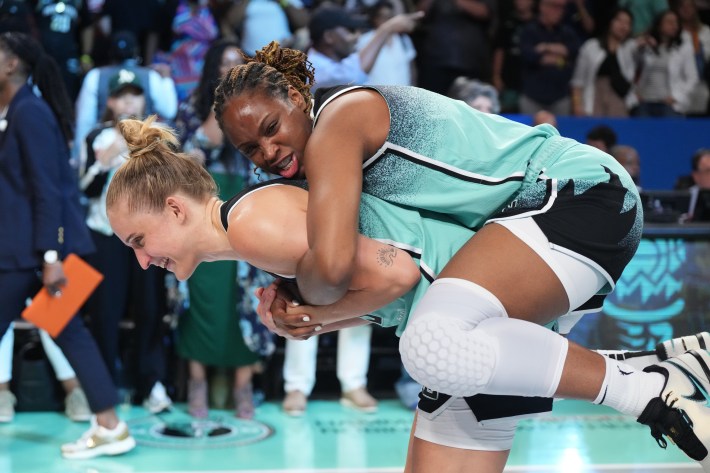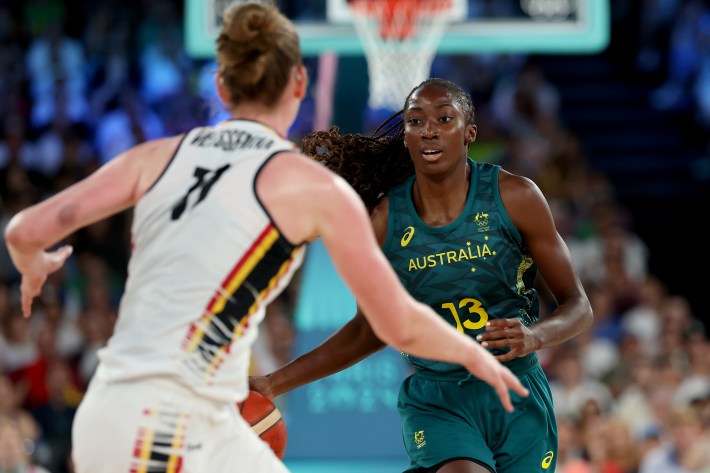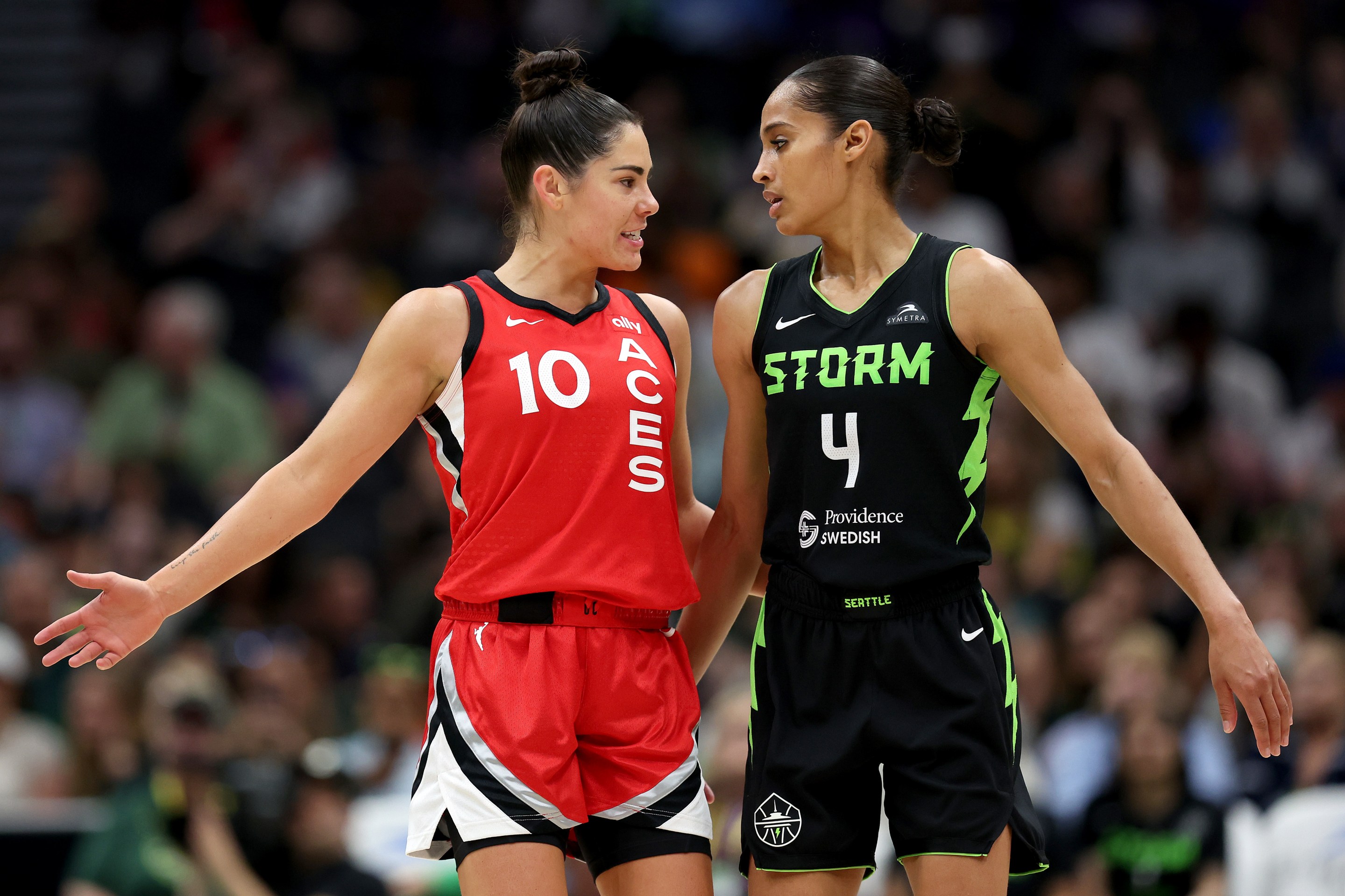What's that? WNBA? Hmmm. W-N-B-A. Is it—that's the one with the women, right? And they're playing basketball? Yes. OK. It's ringing a bell.
So I'm reliably informed that the WNBA will resume play Thursday night after a monthlong Olympic break. During this time, you—certainly not I—may have forgotten every player's name and the result of every game in the first half. To reacquaint ourselves with the goings-on of the league, let's “preview” the second half. Here's one question I have for each team as the season resumes. The teams are listed below by record, from best to worst, which will also help us remember the standings.
New York Liberty (21-4)

Is the bench for real? A year ago, the Liberty went as Breanna Stewart did. Even when she fell into a bit of a shooting slump at the end of the season, Stewart did so much as a defender and rebounder that she found a way to make a difference every game, and they desperately needed anything she could give them. This New York team is talented, but if you'd told me then that the Liberty would lose Stewart for multiple games, I wouldn't expect many wins. But right before the break, Stewart missed a couple of games with an ankle injury. For the revamped Liberty bench, it was no problem; the team stepped up and rolled past Connecticut and Chicago. They might not be quite as entertaining as Marine Johannés, Han Xu and Stef Dolson were, but the new-look group of Leonie Fiebich, Kennedy Burke, Ivana Dojkic and Kayla Thornton has impressed this season, especially on defense. Stewart and Sabrina Ionescu return to New York from the Olympic team, probably both a little tired, so the bench could help keep the team's superstars fresh for October.
Connecticut Sun (18-6)
What difference does Marina Mabrey make? The Sun, famously, wouldn't be the first team to think they were just one Marina Mabrey away from contention. Connecticut traded for the 27-year-old guard right before the break in the hopes that she could offer some more punch on offense. The team could certainly use her three-point shooting. It was a win-now move for a franchise facing an uncertain future. For years, the Sun have been perpetual runners-up, able to make deep playoff runs but always outmatched by the more talented powerhouses in the end. The Sun are 0-3 against the Liberty this year, 0-1 against the Storm, and 0-1 against the Aces, which doesn't inspire much confidence that this season will end differently for Connecticut. Odds are they'll need to beat at least one of those teams to win their first championship. If it doesn't happen for the Sun, next year's no guarantee: Four of the team's starters are free agents this offseason.
Minnesota Lynx (17-8)
Will their rebounding woes hold them back? The Lynx stumbled a bit to end the first half, losing Napheesa Collier at a tough time in the schedule. But the team's fundamentals are strong, and there's plenty of reason to think this can be a team playing deep into October. The three-point shooting is legit; allow me to applaud the season Kayla McBride is having beyond the arc. She is shooting 42.7 percent from three on 7.1 attempts a game. Everyone on the team can do a bit of everything ... except rebound. This really stuck out to me on a quick trip to Minneapolis back in June, when I watched the Lynx struggle with (though eventually beat) an obviously grody and inferior Wings roster. The key takeaway: The undersized Lynx can get pushed around by dominant bigs like the Wings', and when they cede extra possessions to their opponents, they really have to hit shots. So far, they're doing that, but the margins for error are small.
Seattle Storm (17-8)

Is bronze-medal Ezi Magbegor here to stay? Remember that blog here about how unstoppable Emma Meesseman looked all Olympics? Not long after that, Emma was stopped, by—who else?—the great and powerful Ezi. Magbegor led Australia to bronze over Belgium in a legit unbelievable performance, finishing with 30 points, 13 rebounds, three assists, three blocks and two steals. If she simply does that every night, Seattle should be pretty good down the stretch.
Las Vegas Aces (16-8)
How tired are the Aces? In 2021, Storm starters and Team USA members Breanna Stewart, Sue Bird and Jewell Loyd returned home from the Tokyo Olympics. They played one game, looked fantastic, and then plummeted in the standings when fatigue set in. The dagger, an injury to Stewart at the end of the regular season, likely kept them from repeating as WNBA champions that year. The regular season doesn't matter as much as it did back then, when top seeds received byes through two rounds and the rest had to duke it out in single-elimination games, but these Aces might be even more tired. Four of their starters played heavy minutes at the Paris Olympics. Even some of their bench players were in Paris during the break—Megan Gustafson played for Spain and famous Azerbaijani citizen Tiffany Hayes tore it up on the 3x3 courts at Parc Urbain.
Becky Hammon is also not the sort of coach inclined to rest her starters; despite the team's serviceable bench this year, the Aces core has played heavy minutes. Vegas has generally answered the perennial questions about fatigue by being totally awesome and fine every postseason under Hammon. But they're no sure bet to have homecourt advantage in the playoffs right now, and ideally they wouldn't be this far down in the second-half preview before the season's true grind begins.
Phoenix Mercury (13-12)
Can the Mercury be normal? I have enjoyed watching the misshapen Mercury, maybe more so than any other team this year. In the offseason, they built the whole plane out of wings. Those versatile additions have helped them withstand some injuries, and kudos to Nate Tibbetts for his creativity with this roster. I won't soon forget Natasha Cloud guarding A'ja Wilson. Still, gimmickball has its limits, and the Mercury signaled in the offseason that they want to be more than a punchy League Pass team. Mostly healthy now, but probably missing Bec Allen for some time, do the Mercury have night-to-night consistency in them? Can they rebound and defend well enough to hang with the contenders? Unrelated to any of that: Here is Ellie the Elephant doing the Ashanti scoot in front of Tibbetts and his family at the All-Star game.
i’m howling bad 😭 pic.twitter.com/0n1lxzhfxi
— BRK x BRK (@berealkiiid) July 26, 2024
Indiana Fever (11-15)
What does a rested Caitlin Clark look like? To no one's surprise, Clark's three-point volume is high. Her 8.3 attempts per game are second only to Arike Ogunbowale's 8.7. Of the six WNBA players averaging more than seven attempts from three, her 32.7 three-point percentage is the lowest. (For reference, she was a 37.7 percent three-point shooter at Iowa.) Pro defenses make shooting harder, but I imagine fatigue explains some of the drop, too. Clark shouldered a huge offensive burden at Iowa, played until the very last day of the college basketball season, and then began shouldering another huge offensive burden a couple weeks later. While she looked like a best-in-league playmaker as the first half ended, she also looked like she could use a break. In the Fever's final pre-Olympic game, Clark set the WNBA's single-game assist record with 19 against the Wings. She dazzled in the WNBA vs. USA All-Star game, but went 0-of-7 from three. It bodes well for the Fever that the physically and mentally exhausted version of Clark can still run the show like that. The second-half version should be even more fun.
Chicago Sky (10-14)
Who will score the points? Mabrey requested that trade from Chicago—and the Sky felt more comfortable making it—when Chennedy Carter emerged as the team's primary option. Still, there's a difference between life as the primary option and life as the only option. Mabrey wasn't shooting well this season, but defenses did at least have to pay her some attention. Her absence could make life on offense a lot harder for the Sky in the second half. Expect consistent scoring to be a struggle—more than it already was for the league's worst three-point shooting team. Michaela Onyenwere slots into the starting lineup now as Mabrey's replacement; she's a much better defender and an OK shooter, if not someone who's dramatically changing the look of this team. If the playoffs happen for the Sky, cool. If not, it'll be fun to watch the young core of Carter, Angel Reese and Kamilla Cardoso figure shit out together.
Atlanta Dream (7-17)
What the hell is even going on here? An injury to Rhyne Howard in June didn't help, but the Dream have been a huge drag to watch all season. The team plays slow and tends to mash the same ineffective buttons. It's Tina Charles post-ups all the way down. Atlanta finished the first half on an eight-game losing streak, and they won just one of the 11 games Howard missed. Howard didn't exactly have a restful Olympic break: She won a bronze medal with Team USA in 3x3 basketball, and still looked a step slow in those games. Ideally she and a healthy Jordin Canada can zhuzh up the Dream offense. What's that? They're just going to keep running Tina Charles post-ups? Great.
Los Angeles Sparks (6-18)
What do the Sparks have in Rickea Jackson? Count me among the initial Rickea Jackson skeptics. In college, she traded on tough shots, and I wasn't sure her style would translate; it's hard to make a living that way in the WNBA. To her credit, she's been making those tough shots as a pro. Right now Jackson's one of the more efficient WNBA rookies, and I can see why the Sparks were so high on their fourth-overall pick, a pure hooper if there ever was one. Her calm under pressure belies her inexperience. By the end of the first half, it seemed like she had started to earn her coach's trust, too. Jackson averaged 23.9 minutes in May and 33.3 minutes in July. I'd like to see her improve as a rebounder—she's 6-foot-2—and as a passer, where she can be a little tunnel-visioned. Given their slim playoff chances, the Sparks should keep giving her runway in the second half.
Washington Mystics (6-19)
Can we preorder Paige Bueckers jerseys now, or do we have to wait until April? The delightfully springy Brittney Sykes returned from an early-season injury, played one game in June, looked awesome, and then got injured again. It'll be nice to have her back in the starting lineup.
Dallas Wings (6-19)
What first half? It is true that the Wings are a poorly run and poorly constructed team. It is also true that everything that could have gone wrong in Dallas did go wrong in the first half. Satou Sabally has yet to make her season debut for the Wings, but she already shook off some post-injury rust in Paris, where she led Germany to the Olympic quarterfinals. Maddy Siegrist, who was putting together an intriguing season before she broke her finger in June, will join Sabally back on the roster too. I'm inclined to think the Wings' worst basketball is behind them now. A turn in the lottery might do them some good, but better to give Sabally, an impending UFA, a good reason to stick around.






